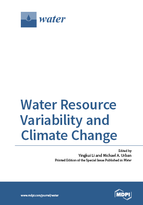Water Resource Variability and Climate Change
A special issue of Water (ISSN 2073-4441). This special issue belongs to the section "Water Resources Management, Policy and Governance".
Deadline for manuscript submissions: closed (20 December 2015) | Viewed by 125261
Special Issue Editors
Interests: LiDAR/UAS and earth surface processes; climate and environmental change; human impacts on environment; GIS and spatial analysis
Special Issues, Collections and Topics in MDPI journals
Special Issue Information
Dear Colleagues,
Climate change affects global and regional water cycling, as well as surficial and subsurface water availability. These changes have increased the vulnerabilities of ecosystems and of human society. Understanding how climate change has affected water resource variability in the past and how climate change is leading to rapid changes in contemporary systems is of critical importance for sustainable development in different parts of the world. This Special Issue focuses on “Water Resource Variability and Climate Change” and aims to present a collection of articles addressing various aspects of water resource variability as well as how such variabilities are affected by changing climates. Potential topics include the reconstruction of historic moisture fluctuations, based on various proxies (such as tree rings, sediment cores, and landform features), the empirical monitoring of water variability based on field survey and remote sensing techniques, and the projection of future water cycling using numerical model simulations. Articles about recent discoveries related to water resource variability in paleoenvironmental reconstruction, hydrology, and geomorphology, as well as articles concerning new emerging technologies and their applications in monitoring water resource variability are all welcome.
Dr. Yingkui Li
Dr. Michael A. Urban
Guest Editors
Manuscript Submission Information
Manuscripts should be submitted online at www.mdpi.com by registering and logging in to this website. Once you are registered, click here to go to the submission form. Manuscripts can be submitted until the deadline. All submissions that pass pre-check are peer-reviewed. Accepted papers will be published continuously in the journal (as soon as accepted) and will be listed together on the special issue website. Research articles, review articles as well as short communications are invited. For planned papers, a title and short abstract (about 100 words) can be sent to the Editorial Office for announcement on this website.
Submitted manuscripts should not have been published previously, nor be under consideration for publication elsewhere (except conference proceedings papers). All manuscripts are thoroughly refereed through a single-blind peer-review process. A guide for authors and other relevant information for submission of manuscripts is available on the Instructions for Authors page. Water is an international peer-reviewed open access semimonthly journal published by MDPI.
Please visit the Instructions for Authors page before submitting a manuscript. The Article Processing Charge (APC) for publication in this open access journal is 2600 CHF (Swiss Francs). Submitted papers should be well formatted and use good English. Authors may use MDPI's English editing service prior to publication or during author revisions.
Keywords
- Global and regional water cycles
- Climate change
- Water resource variability
- Remote sensing of water resources
- LiDAR applications for water resources
- Surface Water fluctuations
- Model simulations of water resources






